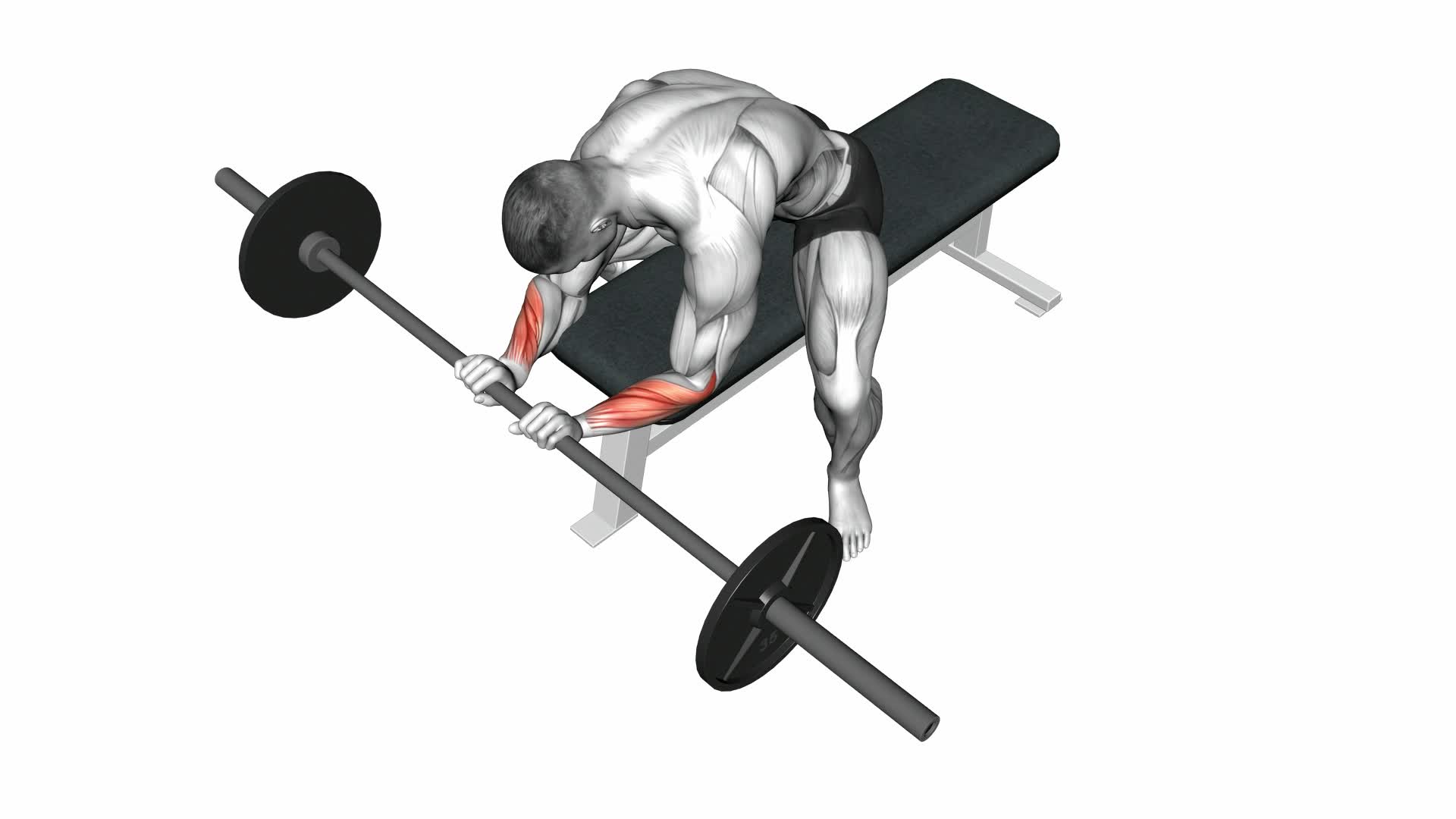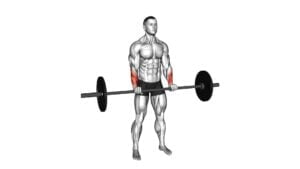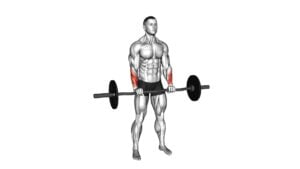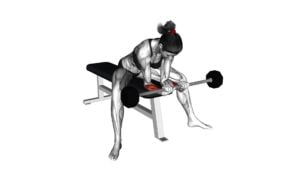Barbell Reverse Wrist Curl – Video Exercise Guide & Tips

Looking to strengthen your wrists and forearms? The Barbell Reverse Wrist Curl is the perfect exercise for you.
Watch This Exercise Video
In this video exercise guide, we'll show you the proper technique and provide helpful tips to maximize your results.
With the right equipment and setup, you'll be on your way to increasing grip strength and improving overall wrist mobility.
Get ready to take your workouts to the next level with this effective variation of the wrist curl.
Key Takeaways
- Increases wrist strength and stability
- Targets muscles in the forearms
- Helps prevent injuries
- Improves grip strength
Benefits of Barbell Reverse Wrist Curl
By performing the barbell reverse wrist curl exercise, you can increase wrist strength and stability while targeting the muscles in your forearms. This exercise is highly beneficial for injury prevention and improving grip strength. Strong wrists are essential for various activities, such as weightlifting, sports, and even everyday tasks like carrying groceries or typing on a keyboard.
By regularly incorporating the barbell reverse wrist curl into your workout routine, you can strengthen the muscles and tendons in your wrists, reducing the risk of strains and sprains. Additionally, this exercise helps improve grip strength, which is crucial for activities that require a strong hold, such as rock climbing or holding onto heavy weights. Developing strong forearms through this exercise can also enhance your overall arm strength and power.
Now, let's move on to the next section to learn about the proper technique for performing the barbell reverse wrist curl.
Proper Technique for Barbell Reverse Wrist Curl
To perform the barbell reverse wrist curl correctly, start by gripping the barbell with an overhand grip and resting your forearms on a bench or your thighs. This exercise primarily targets the muscles in your forearms, including the extensor carpi radialis longus, extensor carpi radialis brevis, and extensor carpi ulnaris.
To begin, sit on a bench or stand with your feet shoulder-width apart. Hold the barbell with an overhand grip, making sure your hands are shoulder-width apart. Rest your forearms on a bench or your thighs, with your palms facing down and your wrists hanging over the edge.
Next, exhale and slowly curl your wrists up towards your body, keeping your forearms stationary. Focus on squeezing your forearms as you lift the barbell. Hold the contraction for a brief moment, then slowly lower the barbell back to the starting position.
Now, let's address some common mistakes to avoid. Firstly, avoid using momentum to lift the barbell. Keep the movement slow and controlled, focusing on the contraction in your forearms. Additionally, make sure to maintain proper form throughout the exercise. Keep your back straight, shoulders relaxed, and core engaged.
Incorporating the barbell reverse wrist curl into your workout routine can help strengthen and tone your forearms. By following these proper techniques and avoiding common mistakes, you can maximize the effectiveness of this exercise and achieve your fitness goals.
Equipment and Setup for Barbell Reverse Wrist Curl
To perform the barbell reverse wrist curl, you'll need a barbell and a bench or a stable surface to rest your forearms on. These are the essential equipment and setup required for this exercise.
Firstly, you'll need a standard barbell. Make sure it's loaded with an appropriate weight for your fitness level and goals. You can adjust the weight by adding or removing weight plates from the barbell.
Next, find a bench or a stable surface that's at a comfortable height for you. It should allow your forearms to rest comfortably while holding the barbell. Ensure that the bench is stable and secure to avoid any accidents or injuries during the exercise.
Position yourself in front of the bench and sit down. Place your forearms on the bench, with your palms facing downwards. Grasp the barbell with an overhand grip, slightly wider than shoulder-width apart.
Maintain a firm grip on the barbell and lift it off the rack or floor. Keep your elbows and upper arms stationary throughout the exercise. Your wrists should be the only joints moving.
Now, you're ready to perform the barbell reverse wrist curl exercise.
Tips for Maximizing Your Barbell Reverse Wrist Curl
To maximize your barbell reverse wrist curl, it's important to focus on proper form and technique. This exercise is great for strengthening your wrists and improving flexibility. Here are some tips to help you get the most out of your workout.
First, make sure you have a solid grip on the barbell. Your hands should be shoulder-width apart, with your palms facing down. Keep your wrists straight throughout the entire movement to target the muscles in your forearms effectively.
When performing the exercise, start with a light weight and gradually increase the resistance as you become more comfortable and confident. It's essential to maintain control and avoid any jerky or sudden movements. Focus on slow and controlled repetitions to fully engage the targeted muscles.
Additionally, pay attention to your breathing. Inhale as you lower the barbell and exhale as you curl it up towards your body. Proper breathing helps stabilize your core and provides support during the exercise.
Lastly, remember to warm up your wrists before starting the exercise. This can be done by performing wrist strengthening and flexibility exercises such as wrist circles or wrist stretches. Warming up properly helps prevent injury and prepares your muscles for the workout.
Variations and Progressions for Barbell Reverse Wrist Curl
To vary and progress your barbell reverse wrist curl, you can incorporate different grip positions and increase the weight resistance. Here are some variations and advanced techniques to take your exercise to the next level:
- Reverse Grip: Instead of using a pronated grip, try using a supinated grip. This will target your forearm muscles in a slightly different way and add variety to your routine.
- Single Arm: Perform the exercise with one arm at a time. This will increase the intensity and challenge your grip strength even more.
- Elevated Wrist: Place your wrists on an elevated surface, such as a bench or step. This will increase the range of motion and provide a greater stretch to your forearms.
- Plate Pinch: Hold a weight plate between your fingers and thumb, pinching it together. This won't only work your wrist flexors and extensors but also improve your pinch grip strength.
When performing these variations, it's important to avoid common mistakes such as using excessive weight that compromises your form, using momentum instead of controlled movements, and neglecting to warm up properly.
To further advance your barbell reverse wrist curl, you can try using wrist straps or perform the exercise on an unstable surface like a balance board.
Remember to always listen to your body and progress gradually to prevent injury.
Frequently Asked Questions
How Many Sets and Reps Should I Do for the Barbell Reverse Wrist Curl?
For the barbell reverse wrist curl, it's important to determine the optimal weight, as well as the number of sets and reps.
To answer your question, the number of sets and reps will depend on your fitness level and goals. Generally, it's recommended to start with 2-3 sets of 10-12 reps. However, you may need to adjust the weight and repetitions based on your own capabilities.
Remember to listen to your body and gradually increase intensity as you progress.
Can the Barbell Reverse Wrist Curl Help With Forearm Strength?
Incorporating the barbell reverse wrist curl into your forearm workout routine can be beneficial for improving forearm strength. This exercise specifically targets the muscles in your forearm, helping to increase their overall strength and endurance.
Additionally, there are variations of the reverse wrist curl exercise that can be used to target different muscles in the forearm, allowing for a more comprehensive workout.
Adding this exercise to your routine can help you achieve stronger and more defined forearms.
Is It Necessary to Use a Barbell for the Reverse Wrist Curl Exercise?
Using a barbell for the reverse wrist curl exercise isn't necessary.
You can also use dumbbells, which offer several benefits. Dumbbells allow for a greater range of motion and can be adjusted to your fitness level.
Additionally, using dumbbells can help improve grip strength and target different areas of the forearm.
Variations of the reverse wrist curl exercise include using a pronated or supinated grip, or performing the exercise on an incline bench.
What Are Some Common Mistakes to Avoid While Performing the Barbell Reverse Wrist Curl?
When performing the barbell reverse wrist curl, it's important to be aware of common mistakes to avoid. Proper form and technique are crucial to prevent injury and maximize results.
Some common mistakes to watch out for include using excessive weight, allowing the wrists to bend forward or backward, and using momentum instead of controlled movements.
Can the Barbell Reverse Wrist Curl Help Improve Grip Strength?
To improve your grip strength, the barbell reverse wrist curl is a great exercise. It targets the muscles in your forearms and wrists, which are crucial for a strong grip.
Athletes can benefit from this exercise as it helps enhance their performance in sports that require a firm grip, like weightlifting and rock climbing.
Additionally, there are variations of wrist curl exercises that can further improve your grip strength, such as dumbbell wrist curls and hammer curls.
Conclusion
In conclusion, the barbell reverse wrist curl is an effective exercise for strengthening your forearms and improving grip strength.
By following the proper technique and using the right equipment, you can maximize the benefits of this exercise.
Remember to start with a weight that challenges you but allows for proper form, and gradually increase the weight as you get stronger.
Don't forget to incorporate variations and progressions to keep challenging your muscles.
Keep up the great work!

Author
Years ago, the spark of my life’s passion ignited in my mind the moment I stepped into the local gym for the first time. The inaugural bead of perspiration, the initial endeavor, the very first surge of endorphins, and a sense of pride that washed over me post-workout marked the beginning of my deep-seated interest in strength sports, fitness, and sports nutrition. This very curiosity blossomed rapidly into a profound fascination, propelling me to earn a Master’s degree in Physical Education from the Academy of Physical Education in Krakow, followed by a Sports Manager diploma from the Jagiellonian University. My journey of growth led me to gain more specialized qualifications, such as being a certified personal trainer with a focus on sports dietetics, a lifeguard, and an instructor for wellness and corrective gymnastics. Theoretical knowledge paired seamlessly with practical experience, reinforcing my belief that the transformation of individuals under my guidance was also a reflection of my personal growth. This belief holds true even today. Each day, I strive to push the boundaries and explore new realms. These realms gently elevate me to greater heights. The unique combination of passion for my field and the continuous quest for growth fuels my drive to break new ground.







